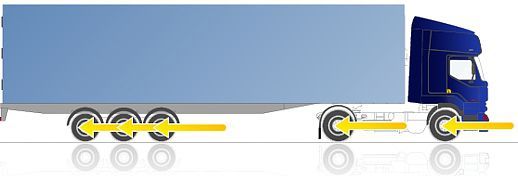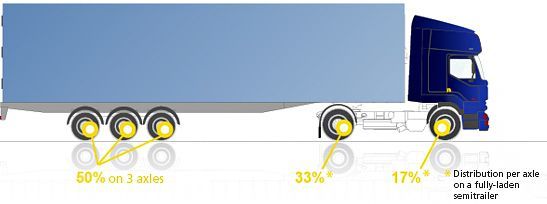1.Choosing Your Tyres
YUELONG offers a wide variety of choices, capable of adapting its tyres to different types of vehicles, journeys and conditions. In compliance with legislation and the necessary technical requirements, YUELONG can help you choose and fit the most appropriate tyre.
There are three main types of axle for HGVs: Front steer axle, drive axle and carry axle. To drive safely and optimise your profitability, respect certain criteria when choosing your tyres. 3 steps to follow:
(a) Decide on the correct use for your tyre. Make your selection from among the ranges of YUELONG tyres. Each range corresponds to different requirements and conditions of use for hauliers.
(b) Decide on the right size of tyre. The maximum load for an axle is given by the vehicle manufacturer depending on current regulations. Simply fitting tyres that can bear a greater load to an axle does not mean it is possible to take on loads greater than those approved by the manufacturer. There are wheels that correspond to each size of truck tyre or tyres (width of rim): consult the ETRTO Standards Manual and/or the manufacturer's recommendations. Never fit a tyre to an unapproved rim: there is a risk of damage to the wheel and/or tyre, insufficient contact patch, over working of the tyre casing, grip and longevity can also be affected.
(c) Follow the criteria for choosing the tread pattern of truck tyres according to the position of the axle on the vehicle. When fitting to a front steer axle, you must use steer patterns; when fitting to a drive axle, you must use drive patterns; when fitting to a trailer axle,you must use trailer patterns. These tyres are especially designed for use on a trailer axle and are not designed or intended for use on the front steer axles of powered vehicles. YUELONG shall not be held responsible for the consequences of not following these recommendations.
When fitting to a front steer axle, you must: Use steer tread patterns only. These tread patterns are designed and manufactured to cope with the specific stresses and strains imposed on the steering axles of motor vehicles: dynamic load, axle geometry, high mileage, etc.
When fitting to a drive axle, you must: Use tyres with drive tread patterns exclusively. Drive tread patterns are designed to cope with the specific stresses of drive axles: transmission of engine and brake torque, twin fitment, the highest axle load of the whole vehicle combination.
When fitting to a carry axle, you must: Use tyres with trailer tread patterns exclusively. These tread patterns are designed to cope with the specific stresses and strains of trailer axles: static and dynamic loads, scrubbing, high mileage on the centre axles, etc.
2. Advice and Precautions for Use
(a) Respecting current legislation in your country and the fitment recommended by both vehicle and tyre manufacturers: size, load indices, speed symbols, structure. If the original equipment is modified, check the prevailing regulations in the country. In some countries, the modified vehicle may need to apply for additional authorisation.
(b) Taking into account the variety of conditions for usage. Consider your own specific requirements (long journeys, driving in winter and extreme conditions) to make sure you have the most suitable tyres. It is recommended to fit tyres with similar levels of wear on the same axle. Some countries have a legal requirement for the maximum variation. Depending on the country it is either compulsory, or strongly advised, to fit tyres with the same tread pattern on the same axle.
(c) Never use the tyre in ways other than those for which the technical characteristics have been approved. Certain excessive geometric or abnormal settings for the vehicle can have an adverse effect on the performance of the tyre. Incorrect usage or the wrong choice of tyre for your vehicle can also contribute to the premature wearing of some mechanical parts.
3. Rolling resistance
To be able to move, energy is required. To reduce fuel consumption, it is necessary to reduce the effects of the forces that resist the movement of vehicles (the gravity related to the weight of the vehicle, air resistance, mechanical friction). Rolling resistance on tyres, very often underestimated, is nevertheless responsible for one third of fuel consumption.
Aerodynamic drag, gravity and inertia

Mechanical friction and engine efficiency

Rolling resistance of tyres

4. The wheel is a genuine vehicle safety element
(a) It ensures an airtight fit with the tyre
(b) It bears the load
(c) It helps achieve fuel savings
(d) It transmits power
(e) It helps dissipate heat
(f) It contributes to weight efficiency
(g) It contributes to the vehicle's appearance